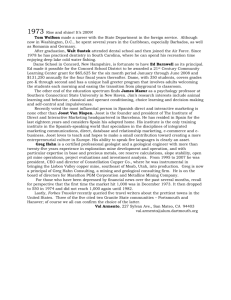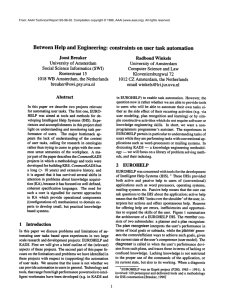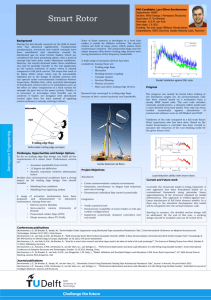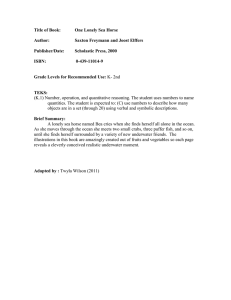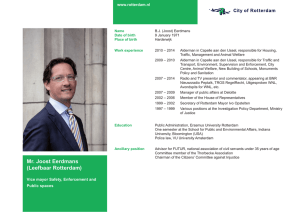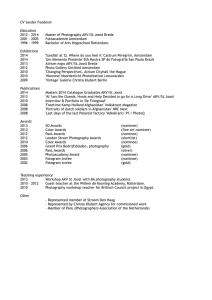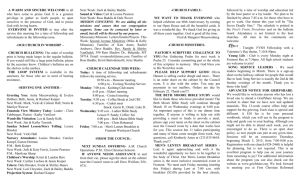Epistemology and ontology in core ontologies FOLaw two core ontologies for law
advertisement
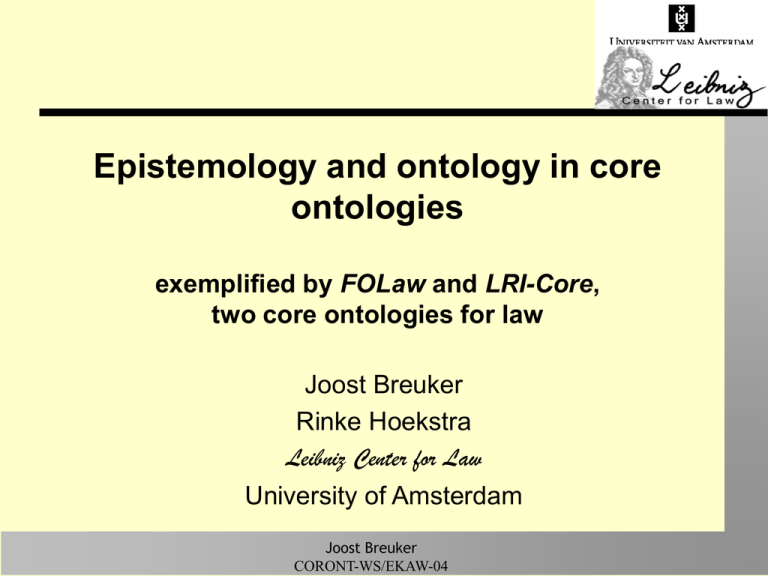
Epistemology and ontology in core ontologies exemplified by FOLaw and LRI-Core, two core ontologies for law Joost Breuker Rinke Hoekstra Leibniz Center for Law University of Amsterdam Joost Breuker CORONT-WS/EKAW-04 Leibniz (1647-1716) “Once the characteristic numbers of most notions are determined, the human race will have a new kind of tool, a tool that will increase the power of the mind much more than optical lenses helped our eyes, a tool that will be as far superior to microscopes or telescopes as reason is to vision” from: Philosophical Essays Joost Breuker CORONT-WS/EKAW-04 Leibniz on the slogan level defending ontologies? “Once the characteristic numbers of most notions are determined, the human race will have a new kind of tool, a tool that will increase the power of the mind much more than optical lenses helped our eyes, a tool that will be as far superior to microscopes or telescopes as reason is to vision” from: Philosophical Essays concepts “URI” reasoning by “ars combinatorix” Joost Breuker CORONT-WS/EKAW-04 Overview FOLaw as a `functional’ core ontology for law Epistemological promiscuity in ontologies LRI-Core: a clean(er) ontology for legal domains Joost Breuker CORONT-WS/EKAW-04 FOLaw (Functional Ontology for Law) (Valente, Breuker & Brouwer, 99) Joost Breuker CORONT-WS/EKAW-04 FOLaw’s views Folaw does not follow the classical decomposition of legal domains in public/private law etc Law as controlling social behaviour Legal reasoning follows this pattern as if it it simulates the control model Joost Breuker CORONT-WS/EKAW-04 FOLaw: normative reasoning CASE Joost Breuker CORONT-WS/EKAW-04 FOLaw: causal reasoning Who did what? Who is to be blamed? What has happened? CASE Joost Breuker CORONT-WS/EKAW-04 Experiences with using FOLaw conceptual model for an architecture for legal reasoning (ON-LINE) template for information retrieval and legal question answering in about 10 legal domains/ 4 european projects Joost Breuker CORONT-WS/EKAW-04 However, this is not an ontology…. This is an EPISTEMOLOGICAL FRAMEWORK framework: structure of recurrent elements (= generic model) epistemology: about valid reasoning message from the 80-ies (eg CommonKADS, etc): “separate the domain knowledge from the reasoning” Joost Breuker CORONT-WS/EKAW-04 Then the question is: what is an ONTOLOGY ? Joost Breuker CORONT-WS/EKAW-04 what is an ONTOLOGY ? Oh no!!! not that again Joost Breuker CORONT-WS/EKAW-04 …an ontology is? `formal specification of conceptualization’ (Gruber 94) applies to any modelling! “An ontology defines the terms used to describe and represent an area of knowledge” (Jeff Heflin, OWL-Use cases) ontology: ”the theory or study of being as such; i.e., of the basic characteristics of all reality.” (Encyclopedia Brittanica) in AI: `what is’ ≈> what we know me: an ontology defines the terms used to describe and represent situations in the world Joost Breuker CORONT-WS/EKAW-04 ontology of reasoning classes and its use in specifying a p.s.m. Joost Breuker CORONT-WS/EKAW-04 ….as a CommonKADS inference structure reflecting dependencies Joost Breuker CORONT-WS/EKAW-04 OWL-S: an `ontology’ for web services Joost Breuker CORONT-WS/EKAW-04 Is mixing ontology with epistemology a problem? Yes: No: It is not `clean’. They are reasoning frames by representing reasoning dependencies between types of knowledge (partitions of knowledge bases); not classes (= concept definitions) They limit reuse and interoperability of knowledge Thin line between (functional) meaning and use of knowledge OWL (and other KR formalisms) allow the expression of both IMPORTANT: frameworks are highly useful in reuse Library of Problem Solving Methods e.g. parametric configuration Web services; OWL-S Joost Breuker CORONT-WS/EKAW-04 FOLaw (functional ontology) (Valente, Breuker & Brouwer, 99) domain ontology Joost Breuker CORONT-WS/EKAW-04 LRI-Core: a `clean’ core ontology for legal domains Legal domain ontologies consist for > 90% of common sense knowledge Recurring typical legal terms have still a strong common sense flavour (including terms for norms and legal responsibility) Joost Breuker CORONT-WS/EKAW-04 LRI-core ontology for law including CRIME.NL mental concept foundational (upper) physical ontology concept physical process physical object mental object content intention action document agent legal code legal person social concept role norm organization legal core ontology legal action legally valid norm judge judicial organization normative article Dutch penal responsible crime person legal domain ontology: code (Dutch) criminal law DPC article Joost Breuker CORONT-WS/EKAW-04 Is-a Part-of criminal court Common sense roots in foundation of LRI-Core legal domains cover common sense intuitions about the physical, mental and social world common sense is invariably implicit, because shared no `definitions’ `revisionary views’ in philosophy --> reality vs common sense naïve physics vs qualitative physics needed: `evidence’ from psychological research • • • • cognitive (development) psychology evolutionary psychology neuro-psychology …anthropology… Joost Breuker CORONT-WS/EKAW-04 Major categories covered physical world life mental world roles (= social world) abstract world occurrences Joost Breuker CORONT-WS/EKAW-04 Principles from this view Common sense is explained by an evolutionary view starting with animal `understanding’ and action primacy of physical world `domain specific inference engines’ (neural deficiencies) Physical world: (re-)acting to physical change objects: relatively static • classes/individuals/instances (entities) • individuals have identities; classes have not (<-> OntoClean) processes: kinds of changes of objects • • • • movement as primary change no identity: occur in events… many processes occur persistently (e.g. gravity) (<-> DOLCE) classes/instances (events; equilibrium states) Joost Breuker CORONT-WS/EKAW-04 some further principles humans vs/and other animals (mammals) intentional stance consciousness natural language: manipulation of symbols representing • metaphors, • `reification’ (beliefs, etc.) these all enable the development of worlds beyond the physical world mental world as a metaphor of physical world distinction between behavior and intended behavior • roles creating abstract world (`form’) by metaphorizing `instincts’ about the physical world (eg: grasping entities of the same kind, counting, …) (Lakoff, 2002) Joost Breuker CORONT-WS/EKAW-04 …and a very basic principle… Persistency or occurrence is not a property of any class; it is a property of individuals (`life cycle’) --> no endurant/perdurant distinction (<-> DOLCE) Joost Breuker CORONT-WS/EKAW-04 ..however… we need terms to refer to occurrences entities ((instances of) individual objects) events and states of entities situations and histories of entities causation as the glue between events on the canvas of space and time (a 4D view…) spatial positions temporal moments ‘now’ appears to move by the arrow of time: existence of objects as trajectories in space/time Joost Breuker CORONT-WS/EKAW-04 five `worlds’ of concepts physical world life mental world metaphor intentional stance communication roles matter/energy --> object and process physical and social roles social organization abstract occurence Joost Breuker CORONT-WS/EKAW-04 physical world basic `natural’ concepts: energy & matter basic defined concepts: physical object & process both contain mixtures of energy & matter processes are changes • transfer (changing positions) • changing value (quality; quantity) • transformation (changing type of process or object) types of processes • mechanics: movement & support are core (cf senses & muscles) • thermo-dynamics: heat exchange • chemistry: mixing/changing substances Joost Breuker CORONT-WS/EKAW-04 process and object substance matter is-a quantity is-a is-a energy heat part-of object property electricity process is-a heat exchange movement radiation change-of-substance aggregation mass form force size Joost Breuker CORONT-WS/EKAW-04 change transfer transformation change-of-value Between death, life and mind Biology/life: Living physical objects: agents Processes initiated by agents: actions Actions are intended (goal oriented vs causal) Awareness: communication actions (cf speech acts) Self awareness: reflection Control over reasoning Modeling fellow agents Modeling discourse Joost Breuker CORONT-WS/EKAW-04 the mental world as a metaphor of the physical world mappings: energy --> emotion|motivation matter/substance --> thought/content (information) object ---> mental-object (concept,…) • container ----> mind, memory process ---> mental-process (thinking, memorizing, …) • process --> action mind/body `problem’: person has mind; mind is container of mental entities action: will as `force’ NB: this naïve view is incorrect! (Wenger, 2003) Joost Breuker CORONT-WS/EKAW-04 roles distinguishing between roles define complementary relations requirements for role taking (cf man taking `mother role’) norms, prescriptions role performance may be assessed against role speaker-hearer, student - teacher these `complementary relations’ explain duty/rights relations in legal theories roles are behavioural pre-scriptions role and role taker: e.g. student - person Bad cook, good cook, … violating legal norm social organization: part-of structure of roles Joost Breuker CORONT-WS/EKAW-04 Conclusions A guideline: do not not mix (epistemological) frameworks with ontologies Modelling common-sense cannot be done by consulting experts, but by Legal domains cover the full range of common sense worlds intuition & introspection :-( empirical evidence from cognitive science from the physical to the mental world LRI-Core is under construction (OWL)…in a month a second release… Joost Breuker CORONT-WS/EKAW-04 Leibniz’/Wilkins views on a “conceptual language” The “conceptual dictionary,” in which words are arranged in groups by their meaning, had its first important exponent in Bishop John Wilkins, whose Essay towards a Real Character and a Philosophical Language was published in 1668. Analyzing the mind's contents, drawing up tables of categories of all simple and complex ideas, then assigning a symbol to each of these, one could, it was thought, obtain a language which, eliminating the mediation of words, would be free of the ambiguity and uncertainty of human languages. (The Dictionary of the History of Ideas: http://etext.lib.virginia.edu/DicHist/dict.html) Joost Breuker CORONT-WS/EKAW-04 where it all happens: the world of occurrences “And in order to understand how common sense works, there is nothing better than imagining “stories” in which people behave according to its dictates.” (Ecco, 99) (semi-)Platonic view: ideas/concepts make up our understanding of what happens in the real world: understanding as constructing a model of a situation episodic vs semantic memory (psychology) Individuals vs Classes (A-Box/T-Box distinction) time and space as the referential canvas of situations and events Joost Breuker CORONT-WS/EKAW-04 the world of occurrences-1 situation 1 structural (topological) descriptions of objects in space Joost Breuker CORONT-WS/EKAW-04 the world of occurrences-2 situation 2 inferred: time between situation1 and situation2 Joost Breuker CORONT-WS/EKAW-04 the world of occurrences-3 events & states of objects floor desk teapot break move/fa ll move/fa ll move/fa ll collide ball T-1 move/fa ll move/fa ll T-2 Joost Breuker CORONT-WS/EKAW-04 the world of occurrences-4 identifying processes floor desk support support teapot break move/fa ll move/fa ll move/fa ll collide ball T-1 move/fa ll move/fa ll T-2 Joost Breuker CORONT-WS/EKAW-04 the world of occurrences-5 identifying causation floor desk support support teapot break move/fa ll move/fa ll move/fa ll collide ball move/fa ll move/fa ll Joost Breuker CORONT-WS/EKAW-04 •the world of occurrences-6 limiting causal effects… Why does the desk not move? floor desk support support teapot break move/fa ll move/fa ll move/fa ll collide ball move/fa ll move/fa ll Joost Breuker CORONT-WS/EKAW-04 summary identifying events by recognizing changes, which are viewed as instances of processes (-types) (cf causal-models, Pearl, 2000) identifying causation (= causal relations between events) identifying states as ongoing processes what happens to the forces (heat, energy,…) that are the resources of processes (mental, qualitative simulation) (cf Michotte, 196x) Joost Breuker CORONT-WS/EKAW-04 An experiment CASE unrelated events/states 1 3 2 4 6 CASE related events/states DIRECT 5 7 4 7 1 temporal order ONTOLOGIES LRI-Core extensions Joost Breuker CORONT-WS/EKAW-04 6 5 3 2
